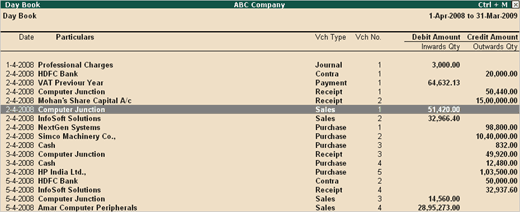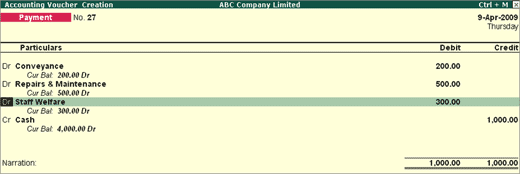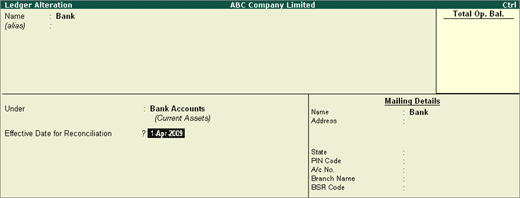1. Name & Mailing Name
Did you know the difference between
Name &
Mailing Name fields available in the company creation screen?
The name provided in the
Name field is displayed in the
Select Company screen and is used to access the Company in
Tally.ERP 9. Where as the Name entered in
Mailing Name field will be printed and displayed in all the output reports of a company.
Example:
Name – ABC (HO)
Mailing Name – ABC Company Limited
2. Financial Year & Books Beginning from
Did you know the difference between the Financial Year from and Books beginning from fields in the Company Creation screen?
Financial Year From: This field indicates the commencement of the financial year for a company, in this case, 1st April 2009.
Books beginning From: The date entered in this field will restrict the user from passing any entry prior to the date mentioned. In other words, vouchers cannot be recorded prior to 1st July 2009, though the financial year begins from 1st April 2009.
3. Delete a line in a voucher
Did you know the shortcut key to delete a line in a voucher is
Ctrl + D?
Simple, Highlight the required line and press Ctrl + D
4. Bank Reconciliation – Effective Date
Did you know how the effective date in Bank Reconciliation feature works?
Use an Effective Date for Bank Reconciliation: A company has data for the current year and/or previous year and wants to use the bank reconciliation facility from a cut off date say 1st August 2009. By specifying the date in
Effective date for Reconciliation field, vouchers
for reconciliation will be considered only from the date specified.
5. Recall Reconciled Vouchers
Did you know that you can recall reconciled vouchers?
Use the
F12: Configure feature to recall the reconciled vouchers of a Bank reconciliation statement to modify or clear the dates for fresh reconciliation.

6. Create Multiple Groups / Ledgers
Did you know that
you to create multiple groups or multiple ledgers from a single screen?
From the
Gateway of Tally >
Accounts Info >
Groups >
Create (Multiple Groups)
Multi Ledger Creation screen is displayed:
7. Create Multiple Aliases for Ledgers
Did you know that Tally.ERP 9 allows you to create multiple aliases for ledgers and assign codes (optional)?
During voucher entry you can select either name of the ledger or any one of the alias.
8. Navigation of Vouchers in Day Book using Page Up and Page Down keys
Did you know that you can view the details of the current voucher in any report?
To view the details of a voucher in a report, highlight the transaction and press
Enter. You can press the
Page Down key to view the details of the next transaction and press the
Page Up key to view the details of the previous transactions.

In
Day Book press
Enter over
Sales Voucher No.1, press
Page Down to view the next transaction (Sales Voucher No. 2) or press
Page Up to view the details of the previous transaction (Receipt No 2).
9. New Company with same Configuration
Did you know that you can create a new company with the same configuration?
To create a new company with the same configuration
F11: Features and
F12: Configurations follow the steps shown:
• Create a Company.
• Set the required
F11: Features and
F12:Configurations as required
• Keep the company loaded
• Create another company
• The new company created will have the same features and configurations
10. Removing a Line and bringing it back in a report
Did you know that you can remove a line and bring it back in
Tally.EPR 9?
This feature can be used to hide a group, ledger and stock item you can press
Alt+R, to recall the hidden line press
Alt+S and to recall the lines in order of removal press
Alt+U























